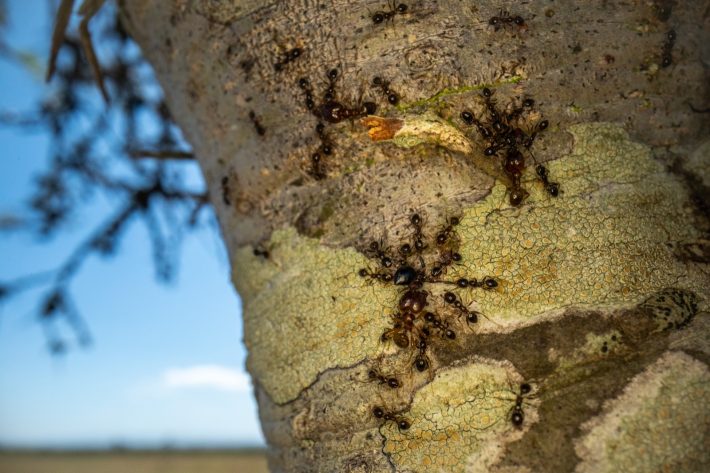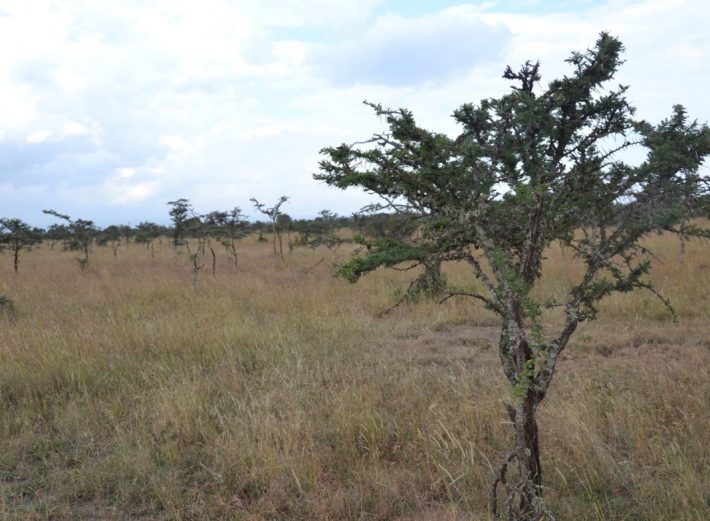University of Florida press release.
New study published in Journal of Ecology reveals how big-headed ants disrupt photosynthesis and plant growth.

Invasive ant species can be found in almost every ecosystem on earth, but the impact these invaders may have on plant health has only recently been investigated by scientists. A new study published in Journal of Ecology is the first of its kind to find that invasive ants can disrupt plants' growth and photosynthesis by nesting at their roots - potentially threatening plants in tropical and subtropical regions around the globe.
The research is led by biologist Pat Milligan, who completed his PhD at UF in 2020 and is now an NSF Postdoctoral Research Fellow in The Pringle Lab at the University of Nevada, Reno. Todd Palmer, UF professor of biology and Milligan's PhD adviser, also contributed to the study.
While studying on-site at a research center in Kenya, Milligan noted that some areas of the conservancy had become heavily occupied by the invasive species Pheidole megacephala, known as "big-headed ants." The species had killed off nearly every other native ant and many of the other native insects in the area. Milligan also began to wonder about the ants' impacts on the health of plants in the region.

In a paper published earlier this year by Ecology Letters, Milligan and his collaborators concluded that the ants were allowing large herbivores like elephants to damage acacia trees, key players in the ecosystem's health. "Still, we had this kind of lingering question about how these invasive ants might be directly interacting with the trees," he said.
While traversing the center's grounds, Milligan observed a peculiar pattern. He watched as the invasive ants formed tunnel networks around the roots of trees - seemingly attracted to the structure already in place to build their homes around. Over the course of two years, Milligan and his collaborators monitored ant-plant interactions through a series of greenhouse and field experiments.
The researchers discovered that plants with ant nests around their roots demonstrated higher baseline water stress. "They're in this state of living that is closer to drying out because of losing their root structure integrity," he said. The experiments also suggest that invasive ants reduce a tree's photosynthesis by more than half and limit carbohydrate availability. In addition, the study showed that sapling growth suffered, jeopardizing chances for survival to adulthood. Milligan's results provide the first visualization of the dangers that ground-nesting invasive ants present for the physiology and growth of plants overall.
It's feasible that it could be happening elsewhere, it's just not something that we've put under a microscope before
Big-headed ants move at a remarkable pace, each colony capable of spreading at distances of 50 meters a year. "It's wild how much the landscape changes before your eyes," Milligan said. "I can point to a tree and remember a time when it wasn't invaded, but now it is and half of it is gone - it's just been ripped to pieces."
The new findings sound an alarm bell: Globally, invasive ants have the potential to build vast nest networks underground, impacting plant health over time. Since this is the first documentation of this interaction, further experimentation is needed. "It's feasible that it could be happening elsewhere, it's just not something that we've put under a microscope before," he said.
Milligan hopes the study will encourage a new wave of research into the relationship between invasive ants and plant species. "I'm excited to see what other researchers might find if they apply the same tools that we do to studying other invasive ants - to see if either this is a weird little phenomenon that's just occurring in our system or if it's a broader issue that we need to discuss in order to prevent negative runaway effects for our environments," Milligan said.
You can read the full article for free (for a limited time) here:
Milligan, P. D., Martin, T. A., Pringle, E. G., Riginos, C., Mizell, G. M., & Palmer, T. M. (2021). A soil-nesting invasive ant disrupts carbon dynamics in saplings of a foundational ant-plant. Journal of Ecology, 00, 1- 15. https://doi.org/10.1111/1365-2745.13803






